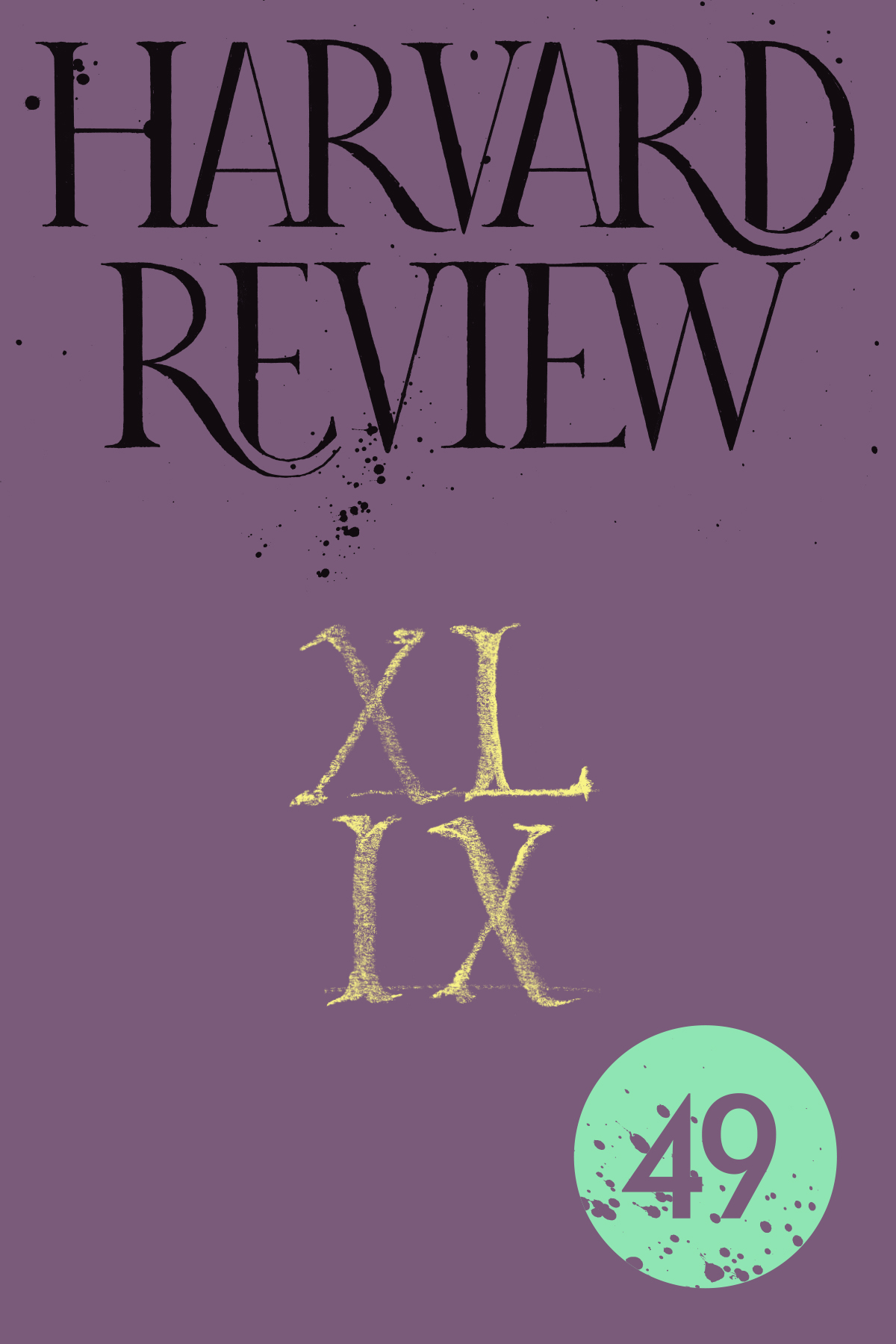HR 49 Editorial
by Paul Harding
Being invited to curate the prose for this issue of Harvard Review is a thrill. Christina Thompson was the first person to publish my fiction, in Harvard Review, in 2002 and again in 2007. For years, while I wrote and tried and failed to publish my first novel, those two stories—those two issues of the review in my bookcase, the one spine bright orange and robin’s egg blue, the other two shades of slate purple—were the only evidence I had that I was a published writer, that I had work with my name on it in print which, as writers know, is practically the same as saying that they were the only evidence that I existed. Those two issues contained, as it were, my collected works. So, when Christina asked if I’d be a guest editor, I was especially gratified and humbled. It felt like my roots as an artist in Harvard Review were striking even deeper, now that I had the chance to find space in it maybe for some younger writers just beginning to publish, as well as for more familiar voices.
I hope that this collection of stories and essays has the same prismatic effect on the reader as it has on me. It was such a pleasure asking teachers, friends, colleagues, students, authors I admired from afar, for some of their writing and receiving in response a kaleidoscopic variety of work—radically various in aesthetics, sensibility, style, but also when read alongside one another hanging together with a kind of coherence that I believe originates in the common humanism of the authors.
Magogodi Makhene’s story, “The Virus,” is a dense, scorching vision set in post-apocalyptic South Africa. Elizabeth McCracken’s essay, “The Container & the Thing Contained,” is a somber, sober, and typically gorgeous reflection on the death of a family member. Erica Funkhouser’s essay, “One Salt Marsh, One Hawk, One Swimmer,” takes the occasion of a swim in a tidal creek in Essex, Massachusetts, and unfolds it into a pastoral transcendentalist meditation. Margot Livesey parses Virginia Woolf’s aesthetics, with her jeweler’s eye for nuance and meaning, and to the benefit of every practicing writer who comes upon it. Tim Horvath’s story, “The Ship of Theseus Sextet,” is like something you’d find in a lost collection by Julio Cortázar—surreal, funny, fractured, and knowing. Matthew Neill Null and Ben Shattuck’s stories feel deeply embedded in history. Null’s “All Was Fine” offers a Pentateuchal elk hunt—dark, primeval, bloody; Shattuck’s “Edwin Chase of Nantucket” captures that weather-swept island and the souls that lived on it in the early nineteenth century. “Authority,” by Sarah Braunstein, seems like it could be happening right this moment across town. Regina Porter’s “Halsey Street” intimately renders place and family and feels like an entire novel perfectly distilled into twenty pages.
And that’s just the prose. The poetry in this issue offers as rich a feast as the fiction and essays, from Tracy K. Smith and Changtai Bi’s translations of sections of Yi Lei’s “Love’s Dance,” which read as if taken from an atlas of dream, to Lauren Brozovich’s “The Ware Collection of Glass Flowers: Delamination,” in which she “peels back” each layer of those glass flowers until she arrives at the human soul that made them.
For the range of subjects and settings, language and artistic disposition, all this work shares a fervid solicitude for and non-negotiable loyalty to the human heart. It also shares an unabashed love for literature, for reading. Every piece here is transparently involved in a dialog with the writer’s own favorite authors, her influences, her inspirations. The idea of the “anxiety of influence” has always seemed like junk ideation to me, the kind of notion that would only occur to and be persisted in by someone who did not make art himself, who held art at arm’s length, perhaps, in his mind, above. But let us not cast aspersions. I don’t mean to mount a critique of the idea, only to use it as counterpoint to set in relief a quality I find common in the present work and in so much successful literary writing, namely the very great privilege of influence. Will any good reader have, say, the sense of Emerson floating alongside Funkhouser—and object? What of a glimpse of Melville across the field in Shattuck, or a whiff of Faulkner’s pipe (not to say bourbon) in the woods on Null’s hunt? What thoughtful reader will not savor such moments where today’s art engages with that of its literary forebears, precipitating one of the greatest effects in all art, namely, recognition.
At the risk of drifting into homily, the Swiss theologian Karl Barth wrote somewhere that human beings are “ordained to fellowship.” It’s fair to say that every work of art deserving of the name is a gesture of fellowship, whatever its idiom or method. It needn’t—it shouldn’t—merely soothe the reader’s conscience. It may—it must—unsettle, haunt, truthfully and thus beautifully describe human experience, and in such descriptions effect recognition, which strikes the reader as revelation of our common humanity. It is in such moments, so particularly the province of art, that we find ourselves in that fellowship to which Barth rightly claims we are ordained.
So with that, fellows, welcome to issue 49 of Harvard Review; I hope you are as surprised and delighted by these wonderful writers as I am.
Published on October 17, 2024
First published in Harvard Review 49

